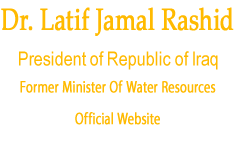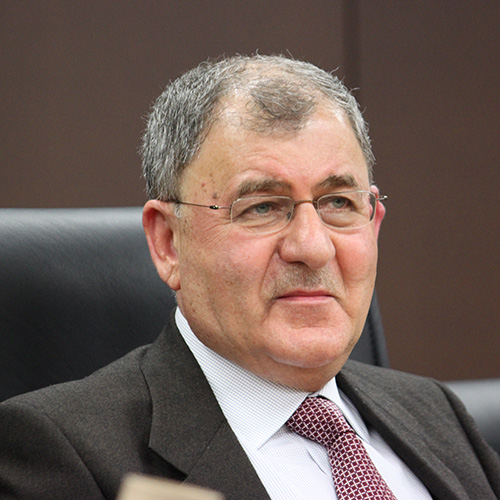Dams
As a steward of the water resources in Iraq, The Ministry of Water Resources has undertaken the task of dams construction in Iraq since 1958 when the first concrete dam ( Dokan Dam) was constructed on the Lower Zab.
The dams located on rivers, watercourses and valleys are of great advantages. They are constructed to control flood and utilize the stored water for agriculture, drinking, electricity generation (which is a clean energy and does not inflict any harm or pollution to the environment) and tourism development through creating an attractive and comfortable locations for residents and citizens who wish to be present there for tourism and leisure. Dams also help improve the environment, climate in the areas surrounding their lakes, as well as, improving the agricultural condition and the living situation for people through providing them with job opportunities in the Dam Project. Furthermore,
The Ministry of Water Resources is working on developing this task through the continuous construction of dams on the rivers, their tributaries and watercourses to achieve the aforementioned goals. The construction of dams comes as a result of the water decline in the rivers Tigris, Euphrates and their tributaries due to the construction of dams by the riparian countries (Turkey, Syria and Iran) on these rivers inside their territories which has led to water deterioration in quality and quantity inside Iraq.
Water shortage and drought are fundamental motivations for the construction of dams. Dams importance can be seen through controlling the stored water, they store access water in flood seasons and release it in drought seasons. Accordingly, Iraq should have a sufficient number of dams to store the required quantities of water.
Drought has drastically increased as a result of actions taken by the riparian countries that utilize water inside their territories for their own benefits. This has led to a deterioration in the quality and quantity of water flows into Iraq which eventually led to thinking of constructing reservoirs on the permanent and seasonable watercourses to utilize water in drought seasons. As a consequence, the Ministry of Water Resources laid down a strategy to construct large and small dams in different areas in Iraq to save and control the available quantities of water and use it properly.
Dams are of several types: Concrete, stony, earth fill with mud core or compacted concrete. Dams have spillway to discharge the excess water that raises above the maximum storage level of the dam.
Large Dams Constructed in Iraq
| Dam Name | Dam Type | Storage Capacity | Dam Body Length | Execution Date |
| Dokan Dam | Arch Concrete | 6,8 billion m3 | 360 m | 1958 |
| Darbandikhan Dam | Rock fill | 3,8 billion m3 | 445 m | 1961 |
| Hemrin Dam | Rock with mud core and stone shell | 3,5 billion m3 | 3,5 km | 1981 |
| Haditha Dam | Rock fill | 8,2 billion m3 | 8923 m | 1985 |
| Mosul Dam | Rock fill | 11,11 billion m3 | 3650 m | 1986 |
| Dohuk Dam | Earth fill | 52 million m3 | 613 m | 1988 |
| Udhaim Dam | Earth fill | 1,5 billion m3 | 3800 m | 1999 |
In addition to the aforementioned large dams, there are a number of constructed and under construction small dams located in Kurdistan Region, the eastern region and the western desert.
Barrages
The barrage is one of the important engineering structures which are constructed on rivers, its tributaries or branches. It`s upstream is used for storing water to provide it to a number of regulators branching from its upstream. The barrage has several openings separated by structures called piers. Soil type should be taken into consideration when constructing a barrage. Some barrages have navigation lock and fish passage especially in the navigational rivers because the construction of the barrage prevents fish passing.
In the construction of a barrage, the maximum discharge should be taken into account so that a sufficient quantity of water is provided for the irrigation projects located at the barrage upstream or at the barrage downstream. The foundation of the barrage is constructed with concrete or reinforced concrete to resist the velocity of water flowing into its openings because water velocity inside the barrage is higher than what it is in the river due to the existence of piers and shrinkage of the river`s width and this requires taking precautions to treat erosion in the downstream of the barrages.
Some barrages have hydropower stations. These stations are used when there are differences between the upstream and downstream levels, this can be seen in Samara Barrage on the Tigris River which has a hydropower station with a generation power of 75 megawatt, Hindiya Barrage which has a hydropower station with a generation power of 15 megawatt in addition to a small hydropower station on Kufa Barrage on the Euphrates River with a generation power of 5 megawatt.
Barrages on the Tigris River and its tributaries
- Debbis Barrage is located on the Lower Zab River and is used for regulating the water of the Zab as well as raising its level for Kirkuk Irrigation Project.
- Diyala Weir is located on Diyala River to provide water for the projects which are located on Diyala River downstream.
- Samara Barrage is located on the Tigris River. Al-Tharthar Regulator and the regulator of Al-Eshaqi Irrigation Project are branched off its upstream.
- Al-Kut Barrage is located on the Tigris River. Shatt Al-Gharraf and Dijela Irrigation Regulator are branched off its upstream
- Al-Amara Barrage is located on the Tigris River. Al-Biterah, Al-Musharah, Al-Areedh and Al-Kahlaa regulators are branched off its upstream.
Barrages on the Euphrates River
- Al-Ramadi Barrage is located in Al-Ramadi City.
- Al-Fallujah Barrage is located 5 km away from the south of Fallujah City.
- Al-Hindiya Barrage is located 1700 m away from the old barrage upstream.
- Al-Kufa Barrage is located in Al-Kufa City.
- Al-Abbasiya Barrage is located on Shatt Al-Abbasiya.
Regulators
All types of regulators whether the main, branch, cross or tail are considered important structures within the irrigation project. They are usually constructed on the head of irrigation canals or at the barrages` upstream on the rivers, their tributaries and branches.
The regulator is designed according to the discharges quantities passing through it. The regulator is constructed with concrete or reinforced concrete and its foundation is designed to withstand water pressure passing through the openings. The openings are separated by structures called regulator`s piers on which the road constructed over the regulator is based. The piers are constructed with concrete or reinforced concrete to withstand water pressure. These piers have different shapes to resist water pressure passing through the regulator.
The regulator has one or several openings and each opening has an iron gate sliding into a slot inside the piers or the support wall. These gates are divided into two types: radial and flat iron. The regulator has a bridge for pedestrian or for vehicles constructed on the regulator and has a device used for lifting the gates either manually or electrically and as required.
The regulator is operated according to the required quantities of water to distribute it to the branch canals in accordance with the requirements of the irrigation projects.
The total number of regulators in the irrigation projects is 2351 and they are of different types: Main, branch, cross and tail regulators distributed across Iraq. There are also 49 large regulators branched from the Tigris and Euphrates River, their tributaries and branches such as: Al-Tharthar regulator in Samara, Al-Warrar Regulator within Al-Habbaniya Project and other regulators that take their water from a number of barrages such as: Samara and Diyala Barrages on Diyala River, Al-Kut and Al-Amara Barrages on the Tigris River, Al-Ramadi, Al-Fallujah and Al-Hindiya Barrages on the Euphrates River.


